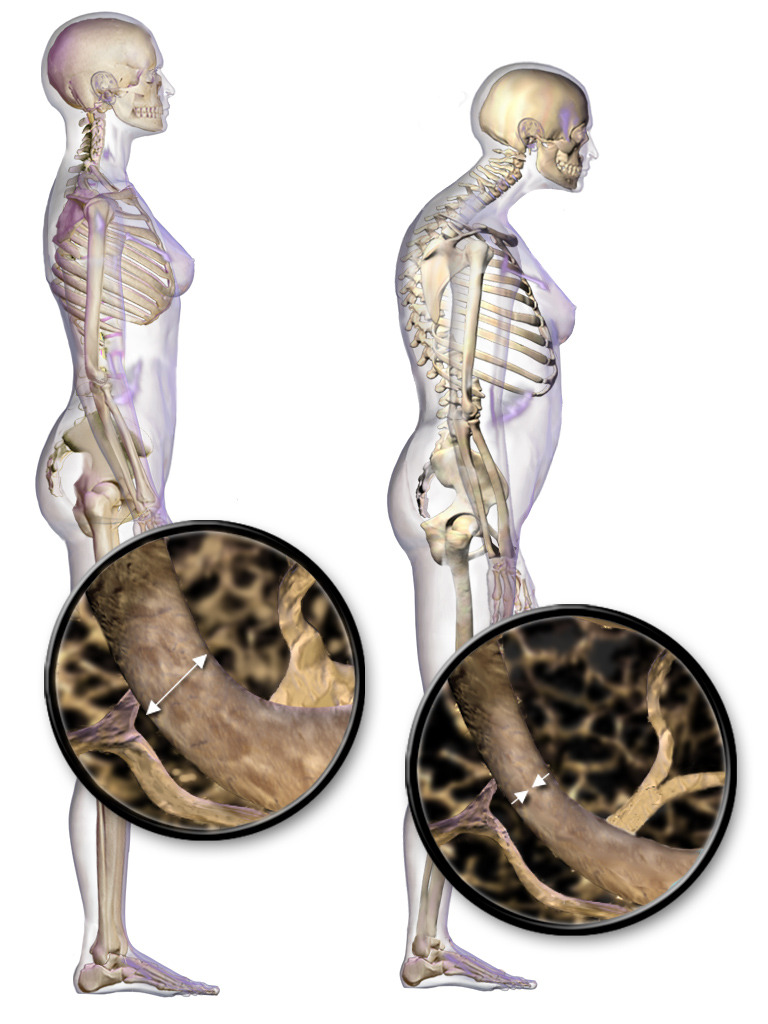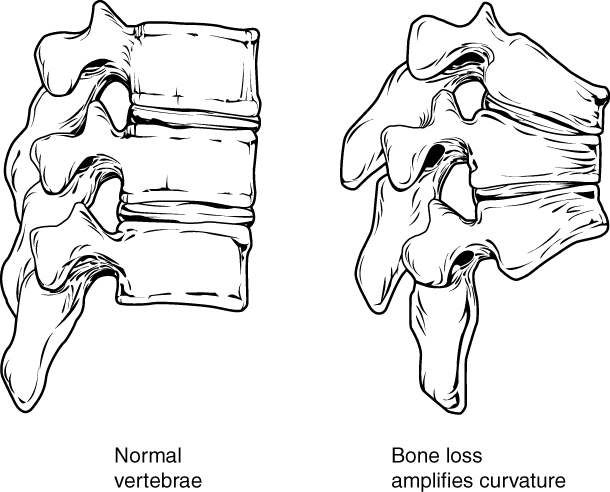Playlist
Show Playlist
Hide Playlist
Osteoporosis: Clinical Presentation and Diagnosis
-
Slides Osteoporosis EndocrinePathology.pdf
-
Reference List Pathology.pdf
-
Download Lecture Overview
00:02 Clinical presentation: Most patients may be in some asymptomatic until there is a massive fracture of either the vertebrae or maybe perhaps the hip that I had mentioned earlier. 00:13 There are greater than one inch loss of height; kyphosis because of issues within the vertebrae and with that kyphosis may then cause restriction of your thoracic cavity, thoracic cage. 00:28 So, therefore, breathing becomes difficult; may result in even restrictive lung disease because of literally physical, mechanical restriction of your lung. 00:39 Focused exam looking for signs of secondary causes, always is in endocrinopathy; is your patient corticoid, so on and so forth. 00:47 Imaging: plain film, not sensitive for detecting early disease, not early on, your bone may actually still look rather normal. 00:59 Lateral films used for-for visualizing spine compression fractures. 01:03 Remember osteopenia, would mean decreased or thinning out of your trabeculae. 01:10 There is something called dual-energy X-ray absorp-absorptiometry known as the DXA scan. 01:17 So, DXA scan, calculated bone mineralized density; bottom-line, that is what a DXA scan will do. 01:25 It will find out as to how dense your bone is. 01:27 So, therefore, once, let?s say a female, has hit menopause, you can expect the DXA scan to show you decreased bone density. 01:36 Measures bone-bone density; mineralization at the spine and your hip, two major sites that you worried about major fractures in a patient with osteoporosis. 01:51 Low bone mineralization density correlates with increased risk of fracture. 01:56 Results express in the following two scores: we have a T-score. 02:01 You want to be at least familiar with what these mean and when you would even use this or apply this. 02:06 A T-score will be used in a patient who you suspect an osteoporosis with your bone mineralization density, expressed in number of standard deviation above or below the mean of normal 30-year old patient. 02:20 Then you have the Z-score, expressed relative to adults of the same age and gender as the patient. 02:27 So, more or less you?re comparing this individual with the rest of the population; T, Z-score being expressed for proper bone mineralization density. 02:40 The scan that you will be using here is called a DXA scan, a dual-energy X-ray absorptiometry. 02:46 WHO criteria for osteoporosis include the following. 02:51 It?s important that you pay attention to the T-score. 02:55 Remember that the T-score is then going to measure as to what your bone mineralization density would be. 03:01 If it?s greater than -1 and then it will be normal; if it?s -1 to -2.5, you start getting into trabeculae thinning out. 03:10 This is referred to as being your osteopenia. 03:13 If it?s less than -2.5, osteoporosis increased porosity and if it gets much less than -2.5, this is important because now you are increased in risk of fractures in two major places - the hip and the spine. 03:32 Indications for DXA scan: postmenopausal. 03:34 Remember, what is DXA scan measuring for? Bone mineralization density. 03:40 Therefore, in a postmenopausal woman, above the age of 50; here we are above 65, for sure. 03:48 Postmenopausal less than 65 years with clinical risk factors, definitely. 03:52 So, now, there?s a family history of osteoporosis in this female and she?s at menopause, clinical risk factors, DXA. 04:01 Aid in decision regarding hormone replacement therapy, if required and by hormone, of course, we are replacing our estrogen. 04:08 Radiologic evidence of osteopenia, meaning to say that you find your trabeculae to be thinned out and there?s prior osteoporotic fractures. 04:17 All these would be indications and your monitoring therapy for osteoporosis. 04:24 The biochemical assessment osteoporosis, what are you looking for? A good place to start would be a CBC and chemistry panel The chemistry panel normally includes calcium, phosphorous and alkaline phosphatase. 04:35 In other words, are not these electrolytes and such and enzymes that you are looking for when you are referring to proper bone homeostasis? Screen, hyperthyroidism could be an issue. 04:49 So, screen for TSH. 04:50 Also, screen for 25. 04:52 Why not 125? Because the major Vitamin D that is circulating in our bodies right now is the 25-type that was hydroxylated by the liver. 05:02 Other tests sent based on history, physical, initial lab; we have something called SPEP and UPEP, 24-urine calcium, intact PTH and testosterone, especially in men. 05:13 These are things that you want to keep in mind as you get into further differentials.
About the Lecture
The lecture Osteoporosis: Clinical Presentation and Diagnosis by Carlo Raj, MD is from the course Bone Disease.
Included Quiz Questions
What is a possible complication of kyphosis?
- Restrictive lung disease
- Hip fracture
- Hypercalcemia
- Vertebral compression fracture
- Endocrine abnormalities
What is NOT a characteristic of a DXA scan?
- The scan is completed at 2 sites, limited to the spine and the knee.
- The scan calculates bone density.
- The scan is expressed as 2 scores.
- The scan uses photon beams of 2 different energy levels.
- The scan involves a comparison to an average mean of a 30-year-old patient.
What does a T-score of -1.5 indicate?
- Osteopenia
- Normal BMD
- Osteoporosis
- Severe osteoporosis
- Nothing of clinical importance
Which patient should get a DXA scan?
- A patient that has been diagnosed with osteopenia
- A 63-year-old woman in good health
- A 60-year-old man with clinical risk factors
- A patient who is on hormone replacement therapy
- A patient with no history of osteoporotic fracture
Customer reviews
5,0 of 5 stars
| 5 Stars |
|
1 |
| 4 Stars |
|
0 |
| 3 Stars |
|
0 |
| 2 Stars |
|
0 |
| 1 Star |
|
0 |
Thank you for the clarity, I feel a bit more comfortable with type of patient care now.





